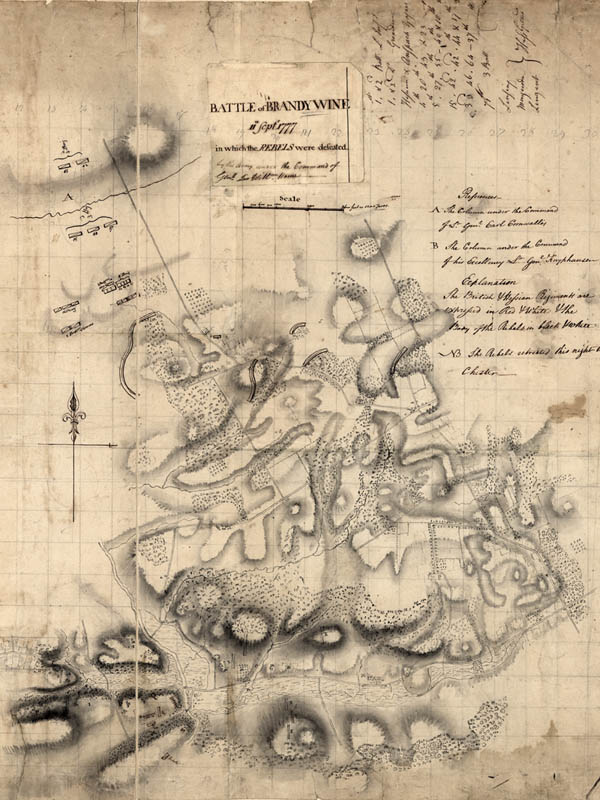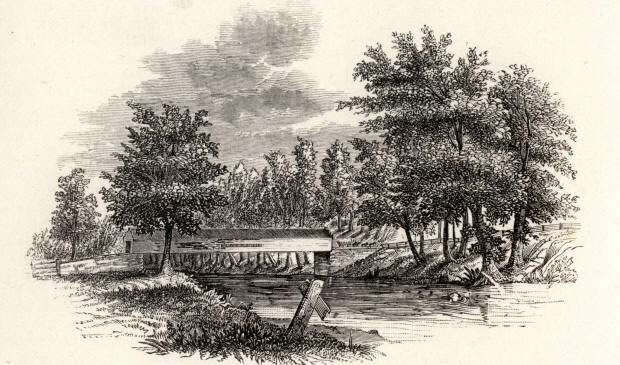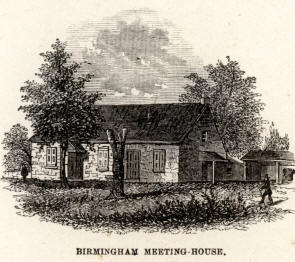Battle on the Brandywine
|
|
This Site:
|
Original 1777 Map of the Battle of BrandywineBrandywine, BATTLE ON THE. When George Washington learned that Howe was ascending Chesapeake Bay in the fleet of his brother, he marched (August 24, 1777) from Philadelphia to meet him. At about the time he reached Wilmington Howe was landing his army, 18,000 strong, at the head of the Elk River, 54 miles from Philadelphia. Washington's effective force did not exceed 11,000 men, including 1,800 Pennsylvania militia. Howe's objective was Philadelphia, and he began his march (September 3) in that direction through a country swarming with Tories. One division was led by Earl Cornwallis, and the other by General Knyphausen. Washington had advanced almost to Red Clay Creek, and sent General Maxwell with his brigade to form an ambuscade in the direction of the enemy. In a skirmish the British were checked, but moved forward (September 8) to attack Washington and turn his flank. By a dexterous movement in the night, the latter fell back to Chad's Ford, on the Brandywine Creek, above Wilmington, and took post in a strong position on the hills that skirt the eastern borders of that stream. The astonished Britons gave chase the next morning, but found Washington standing in their pathway to Philadelphia.
Chad's Ford on the BrandywineThe two divisions of Howe's army met at Kennet
Square (September 10), and the next morning Cornwallis led a large
portion of them up the Lancaster road towards the forks of the
Brandywine, leaving all their baggage --even their knapsacks—with
the other division. The latter moved for Chad's Ford a few hours
later in a dense fog. Washington's left wing, composed of the
brigades of Muhlenberg and Weedon, of Creene's division, and
Wayne's division, with
Proctor's artillery, were on the hills east of Chad's Ford. The
brigades of Sullivan,
Stirling, and Stephen, composing the right wing, extended along the
Brandywine Creek to a point above the forks; and 1,000
Pennsylvania militia
under General Armstrong were at Pyle's Ford, 2 miles below Chad's.
General Maxwell, with 1,000 light troops, was posted on the west
side of the creek to dispute the passage of Knyphausen. The latter
attempted to dislodge Maxwell, who, after a severe fight, was pushed
to the edge of the Brandywine, where he was reinforced. Then he
turned upon his pursuers and drove them back to the main line.
Perceiving danger of being flanked, Maxwell fled across the stream,
leaving its western banks in possession of the enemy. Knyphausen now
brought his great guns to bear upon the Americans at Chad's Ford. It
was to divert Washington's attention from Cornwallis, who was
pushing forward to cross the Brandywine and gain the rear of the
Americans. This accomplished, Knyphausen was to cross over, when a
simultaneous attack by both parties was to be made. Washington
directed Sullivan to cross the Brandywine above and attack
Cornwallis, while he (Washington) should cross the stream and assail
Knyphausen. Through misinformation, Sullivan failed to perform his
part. A message which he sent to Washington kept the latter in
suspense a long time.
Greene, who
had crossed at Chad's Ford with his advanced guard, was recalled;
and Cornwallis, in the mean time, had made a wide
|
|
|
||
|
|
Site Copyright 2003-2018 Son of the South. For Questions or comments about this collection, contact: paul@sonofthesouth.net |
|
|
Are you Scared and Confused? Read My Snake Story, a story of hope and encouragement, to help you face your fears. |
||


 circuit,
crossed the Brandywine, and gained a hill near Birmingham
Meetinghouse, not far from Sullivan's right, before that officer
discovered him. The surprised general informed Washington of his
peril, and immediately prepared to attack the enemy. Before he could
do so, Cornwallis, with his rested troops, fell upon Sullivan, and a
severe conflict ensued. For a while the result was doubtful. Finally
the right wing of the Americans, under General Deborre, gave way;
then the left, under Sullivan; but the centre, under Stirling,
remained firm for a while. Then it, too, broke and fled in
confusion.
circuit,
crossed the Brandywine, and gained a hill near Birmingham
Meetinghouse, not far from Sullivan's right, before that officer
discovered him. The surprised general informed Washington of his
peril, and immediately prepared to attack the enemy. Before he could
do so, Cornwallis, with his rested troops, fell upon Sullivan, and a
severe conflict ensued. For a while the result was doubtful. Finally
the right wing of the Americans, under General Deborre, gave way;
then the left, under Sullivan; but the centre, under Stirling,
remained firm for a while. Then it, too, broke and fled in
confusion.